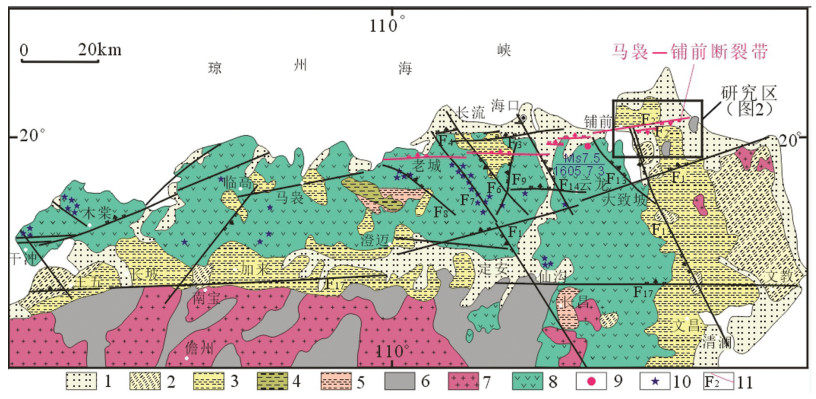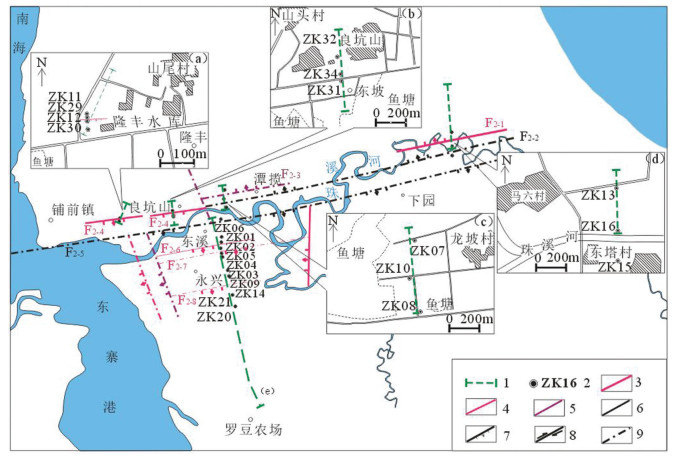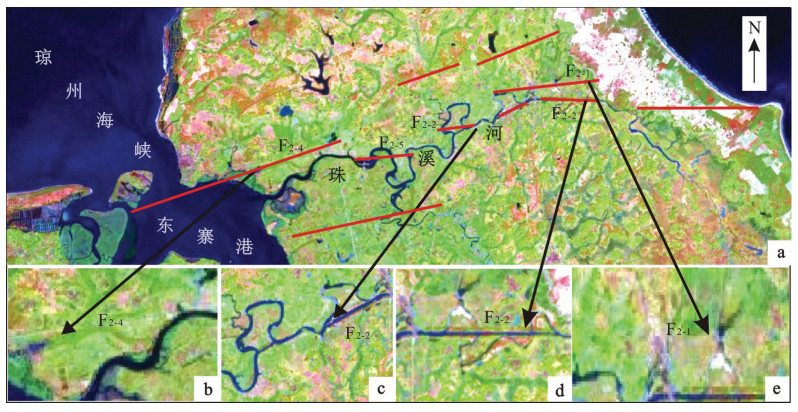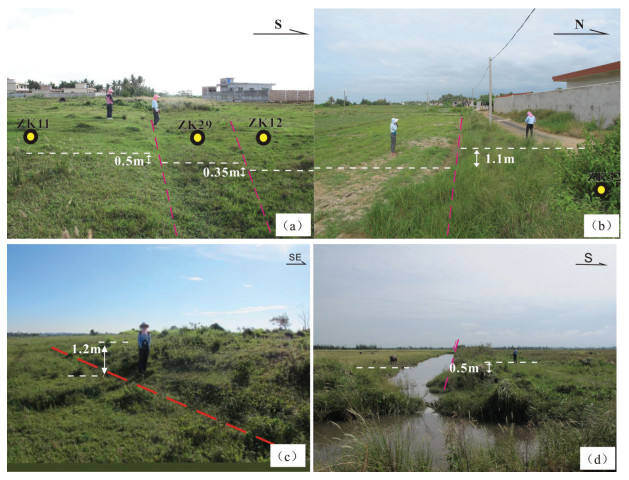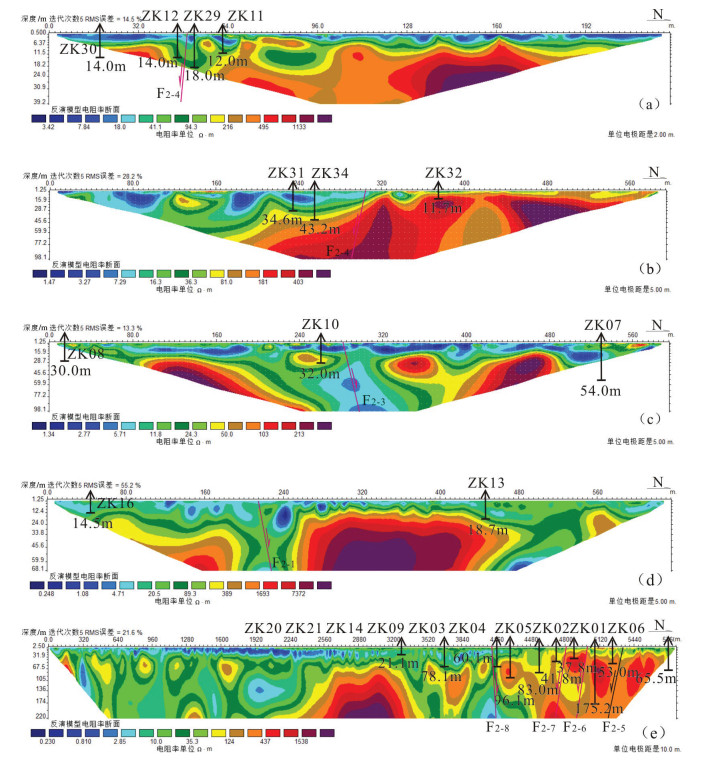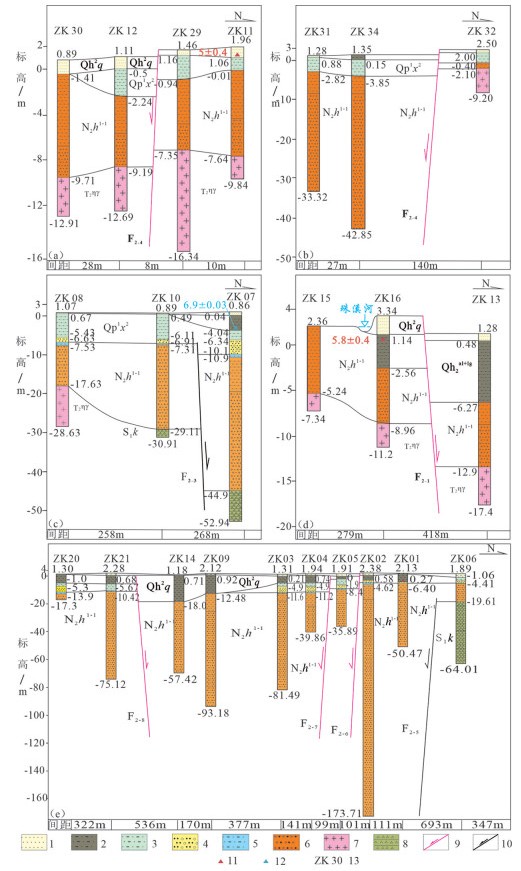Activity of eastern part of the Maniao-Puqian fault in northern Hainan Island and its evaluation of crustal stability
-
摘要:
近东西向展布的马袅—铺前断裂是琼北地区主要活动断裂之一,也是1605年琼山7.5级地震主要控震断裂之一,其活动性对评价海南岛北部地壳稳定性及地质灾害预测有着重要意义。本文通过遥感解译、活动断裂断错地貌填图、高密度电法剖面测量、联孔剖面钻探验证等方法,查明了马袅—铺前断裂东段的空间展布特征:8条北东东向展布、北倾或南倾的正断层F2-1~F2-8组成三堑夹两垒构造,继承上新世之前的多期活动断裂。年代学测试结果鉴别出5条全新世活动断裂(F2-1、F2-4、F2-6、F2-7、F2-8),2条前第四纪断裂(F2-2、F2-5)和1条早中更新世断裂(F2-3);全新世以来F2-1、F2-7、F2-8断裂垂直活动速率为0.43~1.79 mm/a;F2-4、F2-6断裂垂直活动速率为0.12~0.33 mm/a。结果表明,东寨港东岸地区处于不稳定区,应加强断裂活动的监测力度,工程建设时应按照相关标准进行规避。
Abstract:The Maniao-Puqian fault trending east-west, as the major one controlling the Qiongshan earthquake registered 7.5 magnitude on Richter scale in 1605, is a major active fault in the northern Hainan area. Hence, its activity's measuring is critical for crustal stability evaluation and for geological hazard forecast in the northern part of Hainan Island. Various methods were used to determine the distribution of the eastern part of this fault, including remote sensing images interpretation, fault landform mapping, high-density electrical detecting and cross-section drilling validation. The results show that it is spatially composed of 8 north-dipping or south-dipping NEE-trending normal faults (F2-1~F2-8), constituting the three-graben and two-barrier structure, and inheriting the multi-stage activities from the faults before the Pliocene. Five Holocene active faults (F2-1, F2-4, F2-6, F2-7 and F2-8), two pre-Quaternary faults (F2-2 and F2-5) and one early Miocene fault (F2-3) were identified by chronological tests. Moreover, the vertical movement rate of F2-1, F2-7 and F2-8 was 0.43-1.79 mm/a, while that of F2-4 and F2-6 between 0.12-0.33 mm/a since Holocene. The above research shows that the structures in this area are all in an active state, which has a great influence on the future engineering construction, and the monitoring efforts must be strengthened.
-
1. 研究目的(Objective)
锗(Ge)是一种典型的稀散元素,其地壳丰度为1.5×10-6,主要富集在煤和铅锌矿床中。统计结果显示,闪锌矿是铅锌矿床中Ge的主要载体矿物,但不同类型铅锌矿床闪锌矿中Ge的含量存在差异。除热液脉型和浅成热液型铅锌矿床闪锌矿中Ge的含量较高(可达2500×10-6)外,其他主要类型(如喷流沉积型,SEDEX;火山块状硫化物型,VMS;密西西比河谷型,MVT,等)铅锌矿床闪锌矿中Ge的平均含量通常 < 300×10-6。本次发现贵州贵定竹林沟锌矿床闪锌矿中Ge的显著超常富集现象,现报道如下。
2. 研究方法(Methods)
在细致深入的矿床学和矿物学研究基础上,利用激光剥蚀等离子质谱仪(LA-ICP-MS)对竹林沟锌矿床主要金属矿物闪锌矿进行原位微量元素组成分析。统计闪锌矿中Ge等元素的富集特征,结合相关分析和以往研究成果,揭示竹林沟锌矿床中Ge的超常富集机制。
3. 研究结果(Results)
竹林沟锌矿床闪锌矿中Ge的含量为592×10-6~1100×10-6(平均764×10-6,表 1),锌矿石中Ge的平均品位97.9×10-6。闪锌矿LA-ICP-MS微区原位Ge含量分析资料显示,扬子板块及其周缘地区MVT铅锌矿床,如牛角塘、会泽、毛坪、富乐等,其闪锌矿中Ge的含量均 < 652×10-6,即便富乐矿床闪锌矿中Ge的含量最高,但其平均含量也仅为191×10-6,明显比竹林沟锌矿床闪锌矿中Ge的含量(特别是Ge的平均含量)低。
表 1 竹林沟锌矿床闪锌矿部分元素含量(10-6)Table 1. The part elemental contents of sphalerite from the Zhulingou Zn deposit(10-6)
与世界上主要类型铅锌矿床闪锌矿LA-ICP-MS微区原位Ge含量分析资料相比,竹林沟矿床闪锌矿中Ge的含量比SEDEX(Ge含量通常 < 50×10-6)、VMS(Ge含量多数 < 100×10-6)和MVT(Ge含量n×10-6~n×102×10-6,Ge平均含量 < 300×10-6)等闪锌矿中Ge的含量高出一个数量级。竹林沟矿床闪锌矿中Ge的含量与法国Noailhac-Saint Salvy热液脉型Zn-Ge-Ag-Pb-Cd矿床(Ge平均含量750×10-6)和玻利维亚Porco浅成热液型Ag-Zn-Pb-Sn-Ge矿床(n×102×10-6~2500×10-6)等少数类型铅锌矿床闪锌矿中Ge的含量(特别是Ge的平均含量)相当。
可见,竹林沟锌矿床闪锌矿中Ge的含量比目前已知扬子板块及其周缘地区MVT矿床闪锌矿中Ge的含量(特别是Ge的平均含量)都高,且明显高出全球主要类型(除岩浆热液型和热液脉型外)铅锌矿床闪锌矿中Ge的含量(特别是Ge的平均含量)一个数量级,具有显著超常富集特征(接近Ge地壳丰度的1000倍)。
初步分析显示,竹林沟锌矿床闪锌矿中Zn与Ga和Cd之间具有正相关关系;相反,Fe与Ga和Cd之间均具有负相关关系,这表明该矿床闪锌矿中Ga和Cd很可能不是直接替代Zn而是替代Fe,与笔者前期认识基本一致。然而,不难发现该矿床闪锌矿中Zn与Ge之间呈一定的负相关关系,但Fe和Ge之间则呈一定的正相关关系,进一步地Zn与Fe之间具有显著的负相关关系,且Zn与Fe+Ge之间负相关性更显著(图 1)。目前,闪锌矿中主要有六种Ge替代Zn的方式:(1)2Cu++Cu2++Ge4+↔4Zn2+;(2)Ge2+↔Zn2+;(3)2Ag++Ge4+↔3Zn2+;(4)2Cu++Ge4+↔3Zn2+;(5)□(晶体空位)+Ge4+↔2Zn2+;(6)nCu+Ge↔(n+1)Zn。可见,这六种替代方式均不能解释竹林沟锌矿床闪锌矿Zn和Fe+Ge之间的强烈负相关关系。因此,笔者推测该矿床中Ge很可能是与Fe一起共同替代Zn进入闪锌矿晶格(Fe+Ge↔2Zn),是一种新的Ge替代方式。
4. 结论(Conclusions)
竹林沟锌矿床闪锌矿中显著超常富集锗,锗的富集程度接近1000倍,且锗与铁一起共同替代锌进入闪锌矿晶格,是一种新的锗替代方式。初步估算竹林沟锌矿床锗金属储量超过400 t,而竹林沟锌矿床外围还有半边街等锌矿床,初步预测研究区锗资源量可能达到超大型规模(>1000 t),一个新的国家级乃至世界级锗资源基地曙光已现。
5. 致谢(Acknowledgments)
感谢科技部、国家自然科学基金委、云南省科技厅和云南大学对本项目的支持。
致谢: 光释光样品由南京师范大学白世彪老师测试完成,中国地质大学(北京)的游报捷同学在遥感影像处理工作中给予了很大帮助,审稿专家及编辑老师对论文提出宝贵意见,在此一并表示感谢。 -
图 1 马袅—铺前断裂分布图
1—全新统;2—上更新统八所组;3—中更新统北海组;4—下更新统秀英组;5—上新统海口组;6—前新生代基岩;7—花岗岩;8—第四纪玄武岩;9—1605年琼山7.5级地震;10—火山口;11—断裂带;F1-澄迈—冯坡断裂;F2-马袅-铺前断裂;F3—新村—林乌断裂;F4—龙头—博抚断裂;F6—琼华—莲塘断裂;F7—长流—仙沟断裂;F8—颜春岭—道崖断裂;F9—城府—卜亚岭断裂;F13—铺前—清澜断裂;F14—海口—云龙断裂;F17—王五—文教断裂
Figure 1. Structural map showing distribution of the Maniao-Puqian fault
1- Holocene series; 2- Basuo Formation of Upper Pleistocene series; 3- Beihai Formation of Middle Pleistocene series; 4- Xiuying Formation of Lower Pleistocene series; 5- Haikou formation of Pliocene series; 6- Pre- Cenozoic bedrock; 7- Granite; 8- Quaternary basalt; 9- 1605 Qiongshan M7.5 earthquake; 10-Crater; 11-Fault zone; F1-Chengmai-Fengpo fault; F2-Maniao-Puqian fault; F3-Xincun-Linwu fault; F4-Longtou-Bowu fault; F6-Qionghua-Liantang fault; F7-Changliu-Xiangou fault; F8-Yanchunling-Daoya fault; F9-Chengfu-Buyaling fault; F13-Puqian-Qinglan fault; F14-Haikou-Yunlong fault; F17-Wangwu-Wenjiao fault
图 2 电测剖面与钻孔分布位置图
a—山尾村剖面;b—良坑山剖面;c—港头村剖面;d—珠溪桥剖面;e—珠溪河南岸剖面;1—高密度电法测线;2—钻孔及编号;3—全新世活动断层;4—晚更新世活动断层,5—早-中更新世活动断层;6—前第四纪活动断层;7—正断层;8—走滑断层;9—隐伏断层
Figure 2. Distribution of the high-density electrical detecting profiles and drill holes along the eastern Maniao-Puqian faul
a-ShanWei Village profile; b-Liangkeng Village profile; c-Gangtou Village profile; d-Zhuxi Bridge profile; e-South side of Zhuxi River profile; 1-High density electrical detecting line; 2-Drill hole and serial numbers; 3-Holocene Active Fault; 4-Late Pleistocene active fault; 5-Early to middle Pleistocene active faults; 6-Pre-Quaternary active fault; 7-Normal fault; 8-Strike-slip fault; 9-Hidden fault
图 4 马袅—铺前断裂所形成的地表陡坎
a—铺前东南倾断层陡坎;b—铺前南倾断层陡坎;c—珠溪桥北倾断层陡坎;d—罗豆农场北北东东向断裂形成的断层陡坎
Figure 4. Surface scarps along the Maniao-Puqian fault
a-South dipping fault scarp at eastern Puqian Town; b-South dipping fault scarp at Puqian Town; c-North dipping fault scarp at Zhuxi Bridge; d-North-east direction dipping fault scarp at northern Luodou Farm
图 5 马袅—铺前断裂东段高密断电法层析反演图像
a—山尾村剖面;b—良坑山剖面;c—港头村剖面;d—珠溪桥剖面;e—珠溪河南岸剖面
Figure 5. Tomography of high density electrical resistivity along the eastern segment of the Maniao-Puqian fault
a-Shanwei village profile; b- Liangkeng Village profile; c-Gangtou Village profile; d- Zhuxi bridge; e-South side of Zhuxi River
图 6 马袅—铺前断裂东段钻探联孔剖面图
a—山尾村钻孔剖面;b—良坑山钻孔剖面;c—港头村钻孔剖面;d—珠溪桥钻孔剖面;e—珠溪河南岸联孔剖面。1—全新统黄褐色粉细砂(Qh2q);2-全新统青灰色淤泥质黏土(Qh2q);3—下更新统秀英组杂色黏土(Qp1x2);4—下更新统秀英组砾质砂(Qp1x1);5-上新统海口组褐色黏土(N2h1-3);6—上新统海口组砾岩(N2h1-1);7—中三叠系花岗岩(T2ηγ);8-志留系空列村组变质岩(S1k);9—新生断裂;10—前第四纪断裂;11—OSL样品;5±0.4:测年结果/ka B.P.;12—14C样品:6±0.03:测年结果/ka B.P.;13—钻孔孔号
Figure 6. Geological sections of united drilling across the eastern segment of the Maniao-Puqian fault
a-Shanwei Village profile; b- Liangkeng Village profile; c-Gangtou Village profile; d- Zhuxi bridge profile; e-South side of Zhuxi River profile. 1- Holocene silty sand(Qh2q); 2- Holocene cinerous clay(Qh2q); 3- Lower Pleistocene Xiuying Formation variegated clay(Qp1x2);4- Lower Pleistocene Xiuying Formation sandy gravel(Qp1x1);5-Pliocene Haikou Formation brown clay(N2h1-3);6-Pliocene Haikou Formation sandy gravel (N2h1- 1);7- Middle Triassic granite(T2ηγ); 8- Silurian Tuolie Formation gneiss(S1k); 9- Newly- generated faults; 10- Pre- Quaternary fault; 11-Thermoluminescenece samples; 5±0.4:dating result /ka B.P.; 12-14C sample; / dating result ka B.P.; 13-Drilling number
表 1 马袅—铺前断裂东段钻孔揭示标志层断距
Table 1 Vertical offsets of stratigraphic markers revealed by drillings across the eastern segment of the Maniao-Puqian Fault

表 2 钻孔样品年龄测试结果
Table 2 Dating results of the drilling samples

表 3 马袅铺前断裂东段断裂活动性质及时代
Table 3 Activity character and ages of the eastern segment of Maniao-Puqian fault

表 4 马袅—铺前断裂带东段全新世滑动速率
Table 4 Slip rate of the eastern segment of Maniao-Puqian fault during Holocene

-
Cao Xinwen, Ma Xiumin, Hu Daogong. 2017. Application of the resistivity tomography method to detection of active faults northeast of the Hainan Island[J]. Geology and Exploration, 53(5): 1001-1009 (in Chinese with English abstract). http://en.cnki.com.cn/Article_en/CJFDTOTAL-DZKT201705016.htm
Chai Zhizhang, Meng Guangkui, Du Juan, Wang Yin, Liu Baojin, Shen Weihua, Lei Qiyun, Liao Yuhua, Zhao Chengbin, Deng Shaoying, Zhang Xuehui, Xie Xiaofeng. 2006. Comprehensive multilevel exploration of buried active fault: An example of Yinchuan buried active fault[J]. Seismology and Geology, 28(4): 536-546 (in Chinese with English abstract). http://en.cnki.com.cn/Article_en/CJFDTOTAL-DZDZ200604001.htm
Chen Enmin, Huang Yongyin. 1989. Characteristics of the seismic damage and analysis of the seismic structure of the 1605 great earthquake of Qiongzhou, Hainan Island[J]. Seismology and Geology, (3): 319-331 (in Chinese with English abstract). http://en.cnki.com.cn/Article_en/CJFDTotal-DZXB198903010.htm
Ding Yuanzhang, Guo Qinhua. 1988. Structural conditions and seismological mechanism of Qiongshan earthquake[C]//Ding Yuanzhang (ed.). A Collection of Earthquake Studies in Northern Hainan Island. Beijing: Seismological Press, 265-272 (in Chinese).
Dong Haogang, Lu Tao, Li Yiyong, Li Yiyong, Zeng Min. 2016. Quaternary activity of Shawan fault in Pearl River delta[J]. Geology in China, 43(5): 1803-1813(in Chinese with English abstract).
Hu Yaxuan, Hao Ming, Ji Lingyun, Wang Qingliang. 2014. The Characteristics of three-dimensional crustal movement in the northeastern margin of Qiongzhou[C]//Papers Collection of the China Geosciences Joint Academic Annual Meeting, Beijing: China Geophysical Society (in Chinese with English abstract).
Lei Qiyun, Chai Zhizhang, Meng Guangkui, Du Peng, Wang Yin, Xie Xiaofeng, Zhang Xuehui. 2008. Composite drilling section exploration of Yinchuan buried fault[J]. Seismology and Geology, 30(1): 250-263 (in Chinese with English abstract). http://www.oalib.com/paper/1569358
Lei Qiyun, Chai Zhizhang, Meng Guangkui, Du Peng, Wang Yin, Xie Xiaofeng. 2011. Method of locating buried active fault by composite drilling section doubling exploration[J]. Seismology and Geology, 33(1): 45-55 (in Chinese with English abstract). http://en.cnki.com.cn/Article_en/CJFDTOTAL-DZDZ201101007.htm
Li Ping, Yang Meie, Liu Xingsong, Zhao Xiang. 1988. Analysis of active fault in the northern Qiongzhou[C]//Ding Yuanzhang (ed.). A collection of Earthquake Studies in Northern Hainan Island. Beijing: Seismological Press, 41-52 (in Chinese).
Liang Guanghe. 2018. A study of the genesis of Hainan Island[J]. Geology in China, 45(4): 693-705 (in Chinese with English abstract).
Lin Chenghao, Wang Lei, Li Zhejun, Chu Fei. 2017. Application of collocted resistivity tomography and shallow seismic method to the detection of concealed faults in areas with thin covers[J]. Geology and Exploration, 53(1): 133-140 (in Chinese with English abstract). http://en.cnki.com.cn/Article_en/CJFDTOTAL-DZKT201701014.htm
Long Wenguo, Lin Yihua, Shi Chun, Zhou Jinbo, Lü Changyan. 2006a. Revision of the Pleistocene Daotang in northern Hainan Island[J]. Geological Bulletin of China, 25(4): 469-474 (in Chinese with English abstract).
Long Wenguo, Lin Yihua, Zhu Yaohe, Shi Chun, Zhou Jinbo. 2006b. Establishment of the early-mid Pleistocene Duowen Formation on northern Hainan Island[J]. Geological Bulletin of China, 25(3): 408-414 (in Chinese with English abstract). http://en.cnki.com.cn/Article_en/CJFDTOTAL-ZQYD200603011.htm
Qi Bangshen, Feng Chengjun, Tan Chengxuan, Zhang Peng, Meng Jing, Zhang Chunshan, Yang Weimin, Yang Xiaoxiao, Lei Xiaodong. 2019. Application of comprehensive geophysical-drilling exploration to detect the buried North Boundary active fault belt of Yanqing-Fanshan Basin in Sangyuan town, Beijing-Zhangjiakou area[J]. Geology in China, 46(3): 468-481(in Chinese with English abstract). http://en.cnki.com.cn/Article_en/CJFDTotal-DIZI201903004.htm
Wu Zelong. 1988. Discussion on tectonic activity in Dongzhaigang Area[C]//Ding Yuanzhang (ed.). A Collection of Earthquake Studies in Northern Hainan Island. Beijing: Seismological Press, 106-111 (in Chinese).
Xiang Hongfa. 2003. Some problems in the exploratina and research of buried active fault[J]. Seismology and Geology, 25(3): 460-466 (in Chinese with English abstract). http://en.cnki.com.cn/Article_en/CJFDTOTAL-DZDZ200303010.htm
Xu Qihao. 1985. Discussion on subsidence mechanism of Qiongshan earthquake[J]. South China Journal of Seismology, (4): 30-37 (in Chinese).
Xu Qihao. 1986. Formation and migration of Dongzhai Port in the northern Hainan Island and the major Qiongzzhou earthquake of 1605[J]. Seismology and Geology, (3): 94-98 (in Chinese with English abstract). http://en.cnki.com.cn/article_en/cjfdtotal-dzdz198603012.htm
XU Xiwei. 2015. An Introduction to Urban Active Faults in China[M]. Beijing: Seismological Press, 380-403 (in Chinese with English abstract).
Yang Shunhu, Miao Laicheng, Zhu Mingshuai, Li Xingbo, Li Jingchen. 2014. Lata Cenozoic structural deformation and tectono-geomorphic features along the Gobi-Tianshan Fault System[J]. Geology in China, 41(4): 1159-1166(in Chinese with English abstract). http://en.cnki.com.cn/Article_en/CJFDTOTAL-DIZI201404010.htm
Zhang Hunan, Zhao Xitao. 1984. Characteristics of the Neotectonic movement in the Hainan Island and Leizhou Peninsula Area[J]. Chinese Journal of Geology, (3): 276-287 (in Chinese with English abstract). http://en.cnki.com.cn/Article_en/CJFDTOTAL-DZKX198403004.htm
Zhang Lei, Bai Lingyan, Cai Xiangmin, Wang Jiming, Liu Yu, He Fubin, Wang Zhihui, He Jing. 2014. An analysis of the activity of the northwest part of Nankou-Sunhe fault[J]. Geology in China, 41(3): 902-911 (in Chinese with English abstract). http://en.cnki.com.cn/Article_en/CJFDTotal-DIZI201403017.htm
Zhang Linyun, Wang Zhenmin. 1988. Study on the deep depth of artificial seismic exploration in Northeast Qiongdong[C]//Ding Yuanzhang (ed.). A Collection of Earthquake Studies in Northern Hainan Island. Beijing: Seismological Press, 112-116 (in Chinese).
Zhang Shiliang, Zhang Ruihe. 1988. Analysis of fault structures in North Qiongzhou Area by remote sensing technology[C]//Ding Yuanzhang (ed.). A Collection of Earthquake Studies in Northern Hainan Island. Beijing: Seismological Press, 1-9 (in Chinese).
Zhang Xiaoliang, Zhang Lei, Cai Xiangmin, Bai Lingyan. 2016. A study of structure and activity characteristics of the northern segment of Huangzhuang-Gaoliying fault in Beijing plain area[J]. Geology in China, 43(4): 1258-1265 (in Chinese with English abstract). http://www.researchgate.net/publication/316543414_A_study_of_structure_and_activity_characteristics_of_the_northern_segment_of_Huangzhuang-Gaoliying_fault_in_Beijing_plain_area
Zhao Chengbin, Yuan Hongke, Li Deqing, Sun Zhenguo, Zhao Jingrao. 2007. Exploration and study of buried faults under a loose overburden[J]. Journal of Geodesy and Geodynamics, 27(2): 107-1136 (in Chinese with English abstract). http://en.cnki.com.cn/Article_en/CJFDTOTAL-DKXB200702020.htm
Zhao Xitao, Sha Qingan, Feng Wenke. 1978. Holocene beachrocks at Hainan Island[J]. Chinese Journal of Geology, 13(2): 163-173 (in Chinese with English abstract). http://en.cnki.com.cn/Article_en/CJFDTotal-DZKX197802004.htm
Zhou Yi, Guo Gaoxuan, Zhang Lei, Cai Xiangmin, Lei Kunchao. 2016. The division of Quaternary strata and tectonic evolution in Houshayu Sag of Beijing[J]. Geology in China, 43(3): 1067-1075(in Chinese with English abstract). http://www.researchgate.net/publication/308371953_The_division_of_Quaternary_strata_and_tectonic_evolution_in_Houshayu_Sag_of_Beijing
Zou Heping, Huang Yukun. 1987. The tectonic characteristics and evolution of the Qiongbei Cenozoic depression[J]. Geotectonica et Metallogenia, (1): 33-46 (in Chinese with English abstract). http://en.cnki.com.cn/Article_en/ http://search.cnki.net/down/default.aspx?filename=DGYK198701005&dbcode=CJFD&year=1987&dflag=pdfdown
曹新文, 马秀敏, 胡道功. 2017. 电阻率层析成像技术在琼东北活动断裂探测中的应用[J]. 地质与勘探, 53(5): 1001-1009. https://www.cnki.com.cn/Article/CJFDTOTAL-DZKT201705016.htm 柴炽章, 孟广魁, 杜鹏, 王银, 刘保金, 沈卫华, 雷启云, 廖玉华, 赵成斌, 酆少英, 张学辉, 谢晓峰. 2006. 隐伏活动断层的多层次综合探测——以银川隐伏活动断层为例[J]. 地震地质, 28(4): 536-546. doi: 10.3969/j.issn.0253-4967.2006.04.002 陈恩民, 黄詠茵. 1989.1605年海南岛琼州大地震的震害特征和发震构造研究[J]. 地震地质, (3): 319-331. https://www.cnki.com.cn/Article/CJFDTOTAL-DZXB198903010.htm 丁原章, 郭钦华. 1988. 琼山地震的构造条件和发震机制[C]//海南岛北部地震研究文集. 北京: 地震出版社, 265-272. 董好刚, 路韬, 何万双, 黎义勇, 曾敏. 2016. 珠江三角州沙湾断裂带第四纪活动性研究[J]. 中国地质, 43(5): 1803-1813. http://geochina.cgs.gov.cn/geochina/ch/reader/view_abstract.aspx?file_no=20160528&flag=1 胡亚轩, 郝明, 季灵运, 王庆良. 2014. 琼东北缘现今地壳三维运动特征[C]//中国地球科学联合学术年会论文集. 北京: 中国地球物理学会. 雷启云, 柴炽章, 孟广魁, 杜鹏, 王银, 谢晓峰, 张学辉. 2008. 银川隐伏断层钻孔联合剖面探测[J]. 地震地质, 30(1): 250-263. doi: 10.3969/j.issn.0253-4967.2008.01.018 雷启云, 柴炽章, 孟广魁, 杜鹏, 王银, 谢晓峰. 2011. 隐伏活断层钻孔联合剖面对折定位方法[J]. 地震地质, 33(1): 45-55. doi: 10.3969/j.issn.0253-4967.2011.01.005 李玶, 杨美娥, 刘行松, 赵翔. 1988. 琼北地区活动性断裂的研究[C]//丁原章主编. 海南岛北部地震研究文集. 北京: 地震出版社, 41-52. 梁光河. 2018. 海南岛的成因机制研究[J]. 中国地质, 45(4): 693-705. http://geochina.cgs.gov.cn/geochina/ch/reader/view_abstract.aspx?file_no=20180404&flag=1 林承灏, 王雷, 黎哲君, 诸飞. 2017. 电成像与浅层地震联合在浅覆盖区隐伏断层探测中的应用[J]. 地质与勘探, 53(1): 133-140. https://www.cnki.com.cn/Article/CJFDTOTAL-DZKT201701014.htm 龙文国, 林义华, 石春, 吕嫦艳. 2006a. 海南岛北部更新世道堂组的重新厘定[J]. 地质通报, 25(4): 469-474. https://www.cnki.com.cn/Article/CJFDTOTAL-ZQYD200604008.htm 龙文国, 林义华, 朱耀河, 石春, 周进波. 2006b. 海南岛北部第四纪早中更新世多文组的建立[J]. 地质通报, 25(3): 408-414. https://www.cnki.com.cn/Article/CJFDTOTAL-ZQYD200603011.htm 戚帮申, 丰成君, 谭成轩, 张鹏, 孟静, 张春山, 杨为民, 杨肖肖, 雷晓东. 2019. 京张地区延矾盆地北缘活动断裂带桑园镇隐伏段综合地球物理及钻孔地层剖面研究[J]. 中国地质, 46(3): 468-481. http://geochina.cgs.gov.cn/geochina/ch/reader/view_abstract.aspx?file_no=20190303&flag=1 吴泽龙. 1988. 东寨港地区构造活动性的探讨[C]//丁原章主编. 海南岛北部地震研究文集. 北京: 地震出版社, 106-111. 向宏发. 2003. 隐伏活动构造探测研究的若干问题讨论[J]. 地震地质, 25(3): 460-466. doi: 10.3969/j.issn.0253-4967.2003.03.011 徐起浩. 1985. 琼山大震沉陷机理讨论[J]. 华南地震, (4): 30-37. https://www.cnki.com.cn/Article/CJFDTOTAL-HNDI198504003.htm 徐起浩. 1986. 海南岛北部东寨港的形成、变迁与1605年琼州大地震[J]. 地震地质, (3): 94-98. https://www.cnki.com.cn/Article/CJFDTOTAL-DZDZ198603012.htm 徐锡伟. 2015. 中国城市活动断层概论[M]. 北京: 地震出版社, 380-403. 杨顺虎, 苗来成, 朱明帅, 李兴波, 李景晨. 2014. 蒙古戈壁天山断裂带晚新生代构造变形与构造地貌研究[J]. 中国地质, 41(4): 1159-1166. doi: 10.3969/j.issn.1000-3657.2014.04.010 张虎男, 赵希涛. 1984. 雷琼地区新构造运动的特征[J]. 地质科学, (3): 276-287. https://www.cnki.com.cn/Article/CJFDTOTAL-DZKX198403004.htm 张磊, 白凌燕, 蔡向民, 王继明, 刘予, 何付兵, 王志辉, 何静. 2014. 北京平原南口-孙河断裂带北西段活动性分析[J]. 中国地质, 41(3): 902-911. doi: 10.3969/j.issn.1000-3657.2014.03.017 章林云, 王振明. 1988. 琼东北地区人工地震测深研究[C]//丁原章主编. 海南岛北部地震研究文集. 北京: 地震出版社, 112-116. 张世良, 张瑞禾. 1988. 应用遥感技术对琼北地区断裂构造的分析[C]//丁原章主编. 海南岛北部地震研究文集. 北京: 地震出版社, 1-9. 张晓亮, 张磊, 蔡向民, 白凌燕. 2016. 北京平原区黄庄-高丽营断裂北段结构特征及活动特点研究[J]. 中国地质, 43(4): 1258-1265. http://geochina.cgs.gov.cn/geochina/ch/reader/view_abstract.aspx?file_no=20160412&flag=1 赵成斌, 袁洪克, 李德庆, 孙振国, 赵景尧. 2007. 松散覆盖层内隐伏断层探测研究[J]. 大地测量与地球动力学, 27(2): 107-113. https://www.cnki.com.cn/Article/CJFDTOTAL-DKXB200702020.htm 赵希涛, 沙庆安, 冯文科. 1978. 海南岛全新世海滩岩[J]. 地质科学, 13(2): 163-173. https://www.cnki.com.cn/Article/CJFDTOTAL-DZKX197802004.htm 周毅, 郭高轩, 张磊, 蔡向民, 雷坤超. 2016. 北京后沙峪凹陷的第四纪地层划分与构造演化[J]. 中国地质, 43(3): 1067-1075. http://geochina.cgs.gov.cn/geochina/ch/reader/view_abstract.aspx?file_no=20160328&flag=1 邹和平, 黄玉昆. 1987. 琼北新生代坳陷构造特征及其演化[J]. 大地构造与成矿学, (1)33-46. https://www.cnki.com.cn/Article/CJFDTOTAL-DGYK198701005.htm -
期刊类型引用(7)
1. 程涌,周家喜,孙国涛,黄智龙. 贵州半边街锗锌矿床锗的富集特征及其地质意义. 岩石学报. 2024(01): 43-59 .  百度学术
百度学术
2. 何叶,周高明,钟华,程涌,岳正鹏,刘和松,周家喜. 云南毛坪铅锌矿床新发现Ⅵ号矿带硫化物稀散元素富集特征及其地质意义. 岩石学报. 2023(10): 2985-3001 .  百度学术
百度学术
3. 黄亮,周家喜,孙载波,熊波,龙天祥,王晓林,吴嘉林. 滇西漕涧地区发现流纹岩型铌矿化. 矿物岩石地球化学通报. 2022(01): 185-187 .  百度学术
百度学术
4. 杨昌华,周家喜,罗开,姜永果,李晓红,杨丰铭,陶永林. 云南省兰坪-思茅盆地发现钴超常富集矿化点. 大地构造与成矿学. 2022(06): 1167-1169 .  百度学术
百度学术
5. 杨德智,周家喜,孔志岗,吴越,黄智龙,金中国. 闪锌矿矿物结构对Ge超常富集的制约:以贵州竹林沟Ge-Zn矿床为例. 大地构造与成矿学. 2022(06): 1120-1136 .  百度学术
百度学术
6. 罗开,周家喜,徐畅,贺康建,王永彬,孙国涛. 四川乌斯河大型锗铅锌矿床锗超常富集特征及其地质意义. 岩石学报. 2021(09): 2761-2777 .  百度学术
百度学术
7. 周家喜,杨德智,余杰,周祖虎,罗开,徐阳东. 贵州黄丝背斜地区实现大型共(伴)生锗矿床找矿突破. 矿物学报. 2020(06): 772 .  百度学术
百度学术
其他类型引用(0)



 下载:
下载:

